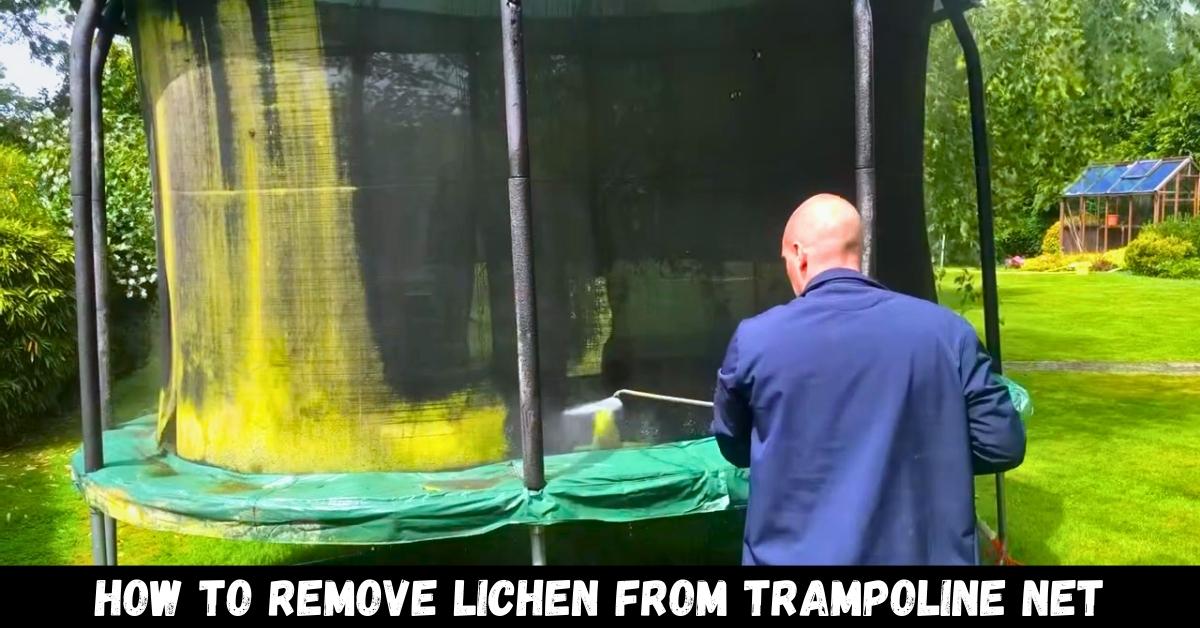Are you tired of dealing with lichen growth on your trampoline net? I understand the frustration, which is why I’m here to help you. Let me guide you through the process of How to Remove Lichen from the Trampoline Net.
As trampoline nets play a crucial role in ensuring safety for you and your kids while having fun, it’s essential to keep them clean and lichen-free. Fortunately, removing lichen from your trampoline net can be made easier with the right detergents and cleaning tools.
By following a few simple steps, you can ensure the longevity and durability of your trampoline net. So, let’s get started on this journey to a clean and enjoyable trampoline experience.
How to Remove Lichen from Trampoline Net: To remove lichen from a trampoline net, wet the net, use a mild detergent or soap, scrub gently with a soft-bristle brush or sponge, and rinse thoroughly with water.
How to Remove Lichen From Trampoline Net: Step By Step Guide
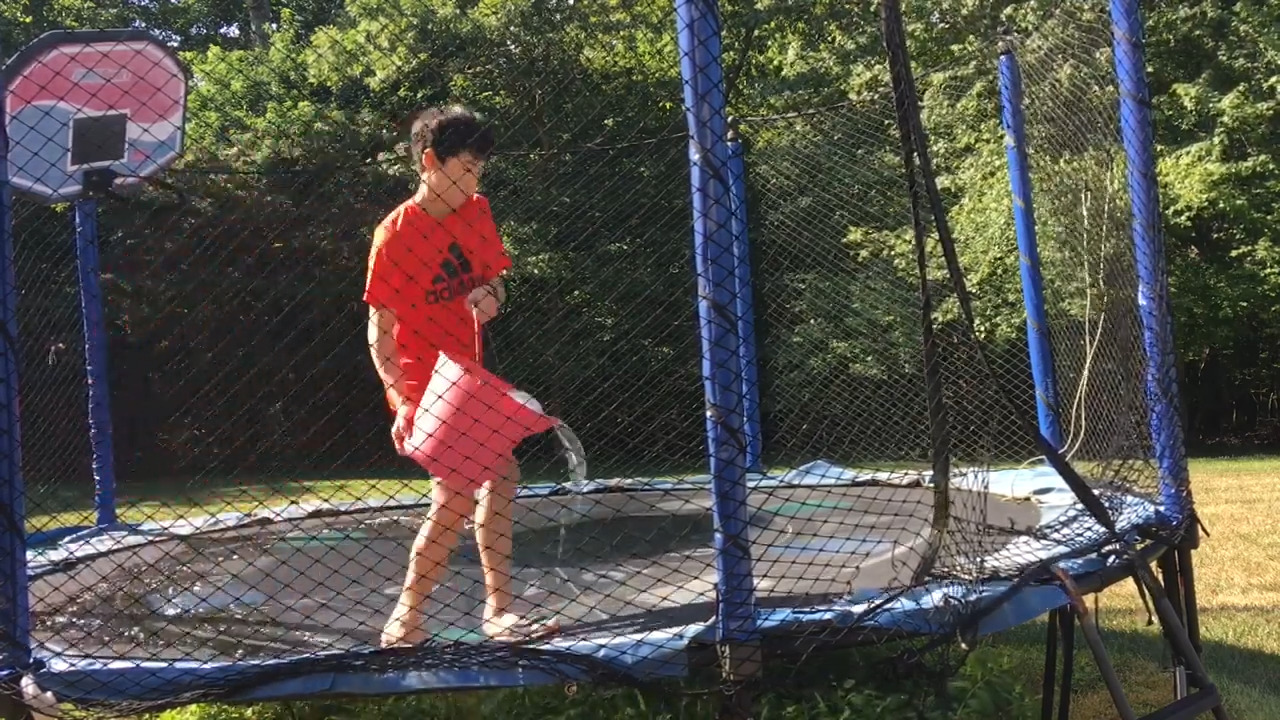
Here’s a step-by-step guide on how to remove lichen from a trampoline net:
Gather Necessary Materials:
Here are some necessary material
Soft-bristle brush or sponge:
Choose a brush or sponge with soft bristles to avoid damaging the trampoline net while cleaning. This will help in effectively removing the lichen without causing any harm.
Mild detergent or soap:
Use a mild detergent or soap that is suitable for cleaning purposes. Avoid harsh chemicals that may cause damage to the trampoline net. The mild detergent or soap will aid in breaking down the lichen and dirt on the net.
Water hose or bucket of water:
Have a water hose or a bucket of water readily available for wetting and rinsing the trampoline net. This will help in loosening and removing the lichen, as well as cleaning away any residue from the detergent or soap.
Having these materials on hand will ensure that you are well-prepared to effectively remove lichen from your trampoline net.
Prepare for the Cleaning Process:
Before you begin, choose a sunny day for quick drying of the trampoline net. If you’re sensitive to lichen, wear protective gloves and old clothes to avoid getting wet.
You have two options: remove the net and wash it by hand or use a hose pipe, similar to those used at car washes. Hand washing allows for thorough cleaning of all areas while using a hose pipe is convenient and time-saving.
Consider your preferences and the level of cleaning needed to determine the best approach. Prioritize safety and cleanliness throughout the process for optimal results.
Remove Loose Lichen from the Trampoline Net:
To remove loose lichen from the trampoline net, gently brush it with a soft bristle brush. Using a soft brush is crucial to protect the net fabric from damage.
By clearing away the loose lichen, you’ll improve visibility and be able to identify any remaining spots where lichen is still present. This step ensures thorough cleaning and helps achieve a lichen-free net.
Taking the time to remove loose lichen guarantees a cleaner and safer trampoline experience for you and your family.
Cleaning the Trampoline Mat:
To clean the trampoline mat, start by rinsing the entire surface with a hose or water from a bucket. Make sure to wear old clothes as this process can be messy. Begin cleaning from an area far from the net entrance.
If you have a pressure cleaner, you can use it to clean the mat. Otherwise, you can rely on your own effort. Use a specialized trampoline soap or detergent to clean the mat. Alternatively, you can create a diluted vinegar solution for the cleaning process.
Avoid using bleach as it can damage plastic parts of the mat. Instead, use a nail brush or a soft brush of a slightly larger size to clean. Do not use a wire brush as it may harm the mat surface.
Moisten the Trampoline Net:
With the loose lichen cleared, it’s now time to get the trampoline net. You can accomplish this by using water from a hose or a bucket. Wetting the net serves the purpose of soaking and loosening the dirt and remaining lichen from the trampoline net.
This step is crucial as it prepares the net for the subsequent cleaning process. By thoroughly wetting the net, you enhance the effectiveness of the cleaning and ensure that the dirt and lichen are adequately loosened and ready to be removed.
Clean the Trampoline Net:
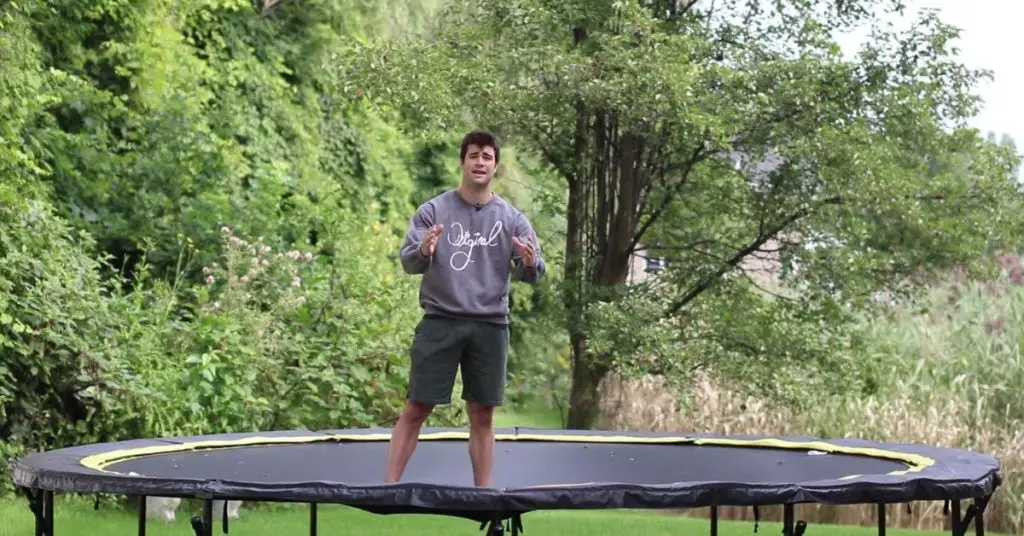
Now it’s time to clean your wet trampoline net. You have two options: you can either use a pressure washer or a soft bristle brush to scrub the net.
If you prefer, you can also add some washing products to the trampoline net. For example, you can use products like “Wet and Forget Original” or mix water with detergent and sprinkle it on the net. This will help in thoroughly cleaning the net and removing any remaining lichen or dirt.
Thoroughly Rinse the Trampoline Net:
Thoroughly rinse the trampoline net with water using a pressure washer. It is crucial to ensure that all the detergents previously applied are completely rinsed off, leaving the net clean and free from any residue.
By taking the time to rinse off the detergents, you ensure that no soapy or chemical remnants are left behind, which could potentially damage the net or cause skin irritation. This step is essential for maintaining a pristine and safe trampoline net.
Once rinsed thoroughly, the net will be ready for drying, preserving its cleanliness and ensuring a pleasant trampolining experience.
Allow the Trampoline Net to Dry:
Once you have rinsed off the detergent from the trampoline net, allow it to air dry in the sun for a period of time. The sunlight’s warmth and energy will aid in evaporating any remaining moisture, ensuring that the net is thoroughly dried before it is ready to be used again.
This step is important as it helps prevent any potential damage or discomfort that may arise from using a damp net. By patiently allowing the net to dry under the sun’s natural heat, you ensure a clean and dry surface, ready for the next trampoline session.
Completing the Cleaning Process:
Once you have thoroughly cleaned all the parts of the trampoline, it’s time to rinse everything off. You can use a garden hose or a bucket of water to ensure a thorough rinse. Make sure to use enough water to remove any detergent or soap residue from the trampoline.
After rinsing, allow the trampoline to air dry naturally, or you can use a towel to remove any excess water from its surface. This will help ensure that the trampoline is completely clean and ready to be used.
Is it safe to wash a trampoline net in a washing machine?
No, you cannot clean your trampoline net in a washing machine. Trampoline nets are not strong enough for machine washing, and they may tear easily. Additionally, the washing machine may not effectively remove all the dirt and growth on the net.
It’s also inconvenient to detach the net from the trampoline for washing. Regular cleaning is essential to prevent lichen growth and prolong the trampoline’s lifespan.
Drying and Maintenance
Here we discuss the drying and maintenance:
Air Dry the Net:
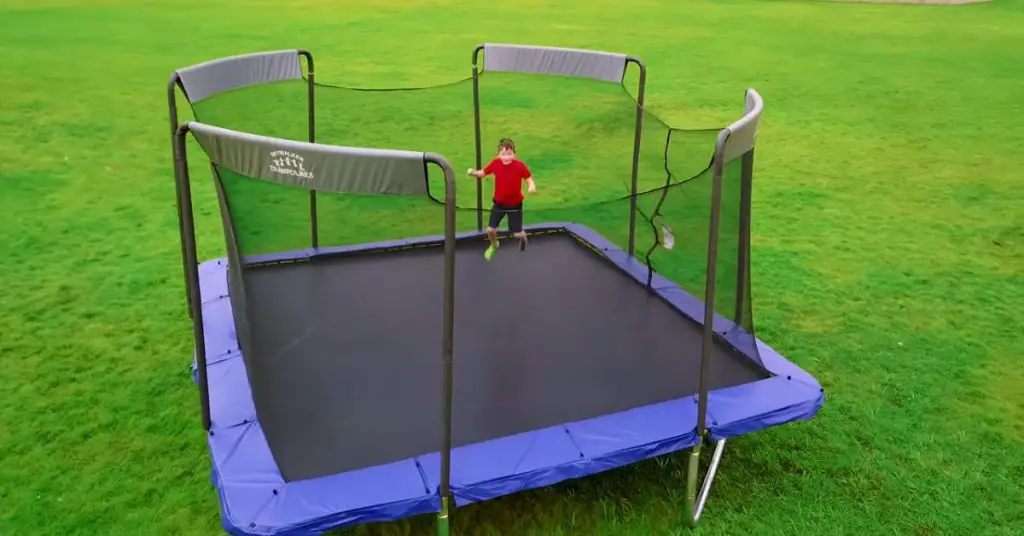
Once you have cleaned the trampoline net, it is crucial to let it air dry completely. Make sure there is no moisture left on the net before using the trampoline again.
This step is essential as it helps prevent any possible damage or deterioration that can occur due to lingering moisture. Allowing the net to air dry thoroughly ensures that it remains in good condition and is ready for safe use.
By ensuring a dry surface, you maintain the integrity of the trampoline net and contribute to its longevity and continued enjoyment for years to come.
Check for Remaining Lichen/Stains:
After the net has completely dried, perform a thorough examination to check for any remaining lichen or stubborn stains that may still be visible. Pay particular attention to areas that were heavily affected by lichen growth.
If you observe any lingering lichen or stains, take appropriate measures to address them. This may involve repeating the cleaning process or applying targeted cleaning techniques to effectively remove the remaining lichen or stains.
By diligently addressing any residual issues, you ensure that the trampoline net is clean, free from unsightly marks, and ready for safe use.
Repeat Cleaning as Needed:
In the case of persistent lichen or stubborn stains, it may be necessary to repeat the cleaning process on specific areas of the trampoline net.
Use the appropriate cleaning tools and solutions as previously described to gently scrub and remove any remaining lichen or stains. Be cautious not to apply excessive force or use abrasive materials that could damage the net.
Regular Inspection and Cleaning:
To keep the trampoline net clean and in good condition, it is important to conduct regular inspections and cleanings. Stay vigilant for any signs of lichen growth or the accumulation of dirt.
By consistently cleaning the net, you can prevent the buildup of lichen and maintain a safe and enjoyable trampolining experience. Regular maintenance not only ensures cleanliness but also extends the net’s lifespan.
By taking proactive measures and promptly addressing any issues, you can preserve the cleanliness and integrity of the trampoline net, allowing for continued fun and safe bouncing for years to come.
Apply Protective Coating for Lichen Prevention:
As a preventive measure, you may consider applying a protective coating or treatment to the trampoline net. There are products available specifically designed to inhibit lichen growth on various surfaces.
Follow the manufacturer’s instructions carefully when applying such products to ensure their effectiveness and compatibility with the trampoline net material.
This additional layer of protection can help reduce the likelihood of future lichen growth and make future cleaning easier.
By following these steps and incorporating regular maintenance into your trampoline care routine, you can ensure a clean and safe trampoline net, free from lichen and other debris, and extend its overall lifespan.
Safety Precautions
Here are some safety precautions:
Wear Protective Gloves while Cleaning:
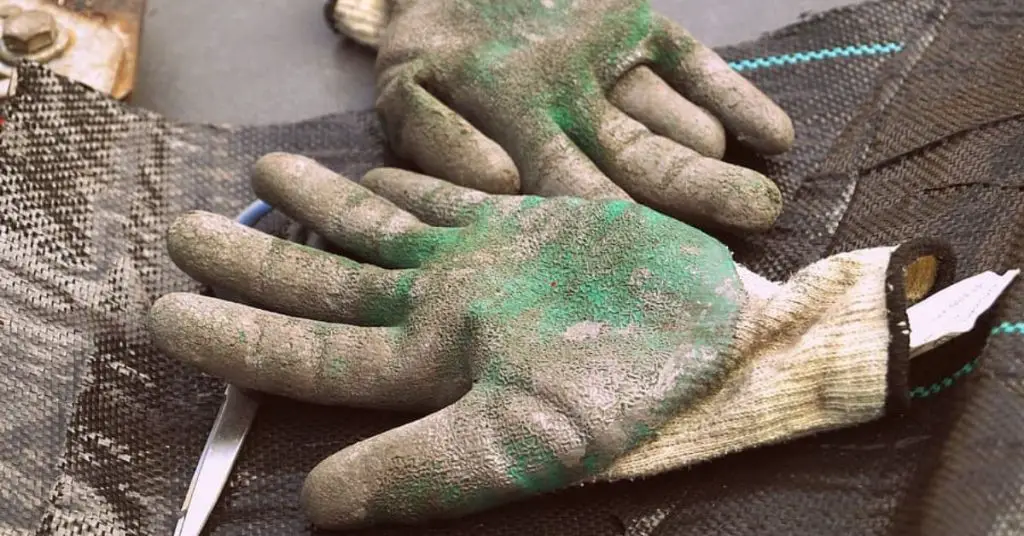
To safeguard your skin from potential irritation or harmful substances, it is crucial to wear protective gloves when cleaning the trampoline net.
Gloves serve as a barrier, minimizing the risk of direct contact with cleaning solutions or potentially irritating substances.
By wearing gloves, you provide an added layer of protection for your hands, reducing the chances of skin irritation or adverse reactions. This precautionary measure promotes safety and ensures a more comfortable cleaning experience.
Prioritizing your well-being by wearing protective gloves contributes to a positive and hassle-free trampoline net cleaning process.
Use Mild Detergents to Prevent Damage:
When selecting cleaning products for the trampoline net, opt for mild detergents specifically designed for the purpose. Harsh detergents can cause damage to the net material, compromising its integrity and lifespan. Mild detergents are effective in removing lichen and dirt while being gentle on the net.
Avoid Harsh Chemicals or Abrasive Materials:
It is crucial to avoid using harsh chemicals or abrasive materials during the cleaning process, as they can cause significant damage to the trampoline net.
Harsh chemicals may degrade the net’s material, leading to weakening or tearing. Similarly, abrasive materials can scratch or abrade the surface of the net, reducing its durability.
By adhering to these safety precautions, you can ensure a safe and effective cleaning process while protecting both yourself and the trampoline net from potential harm or damage.
Additional Tips and Warnings
Here are some additional tips and warnings:
- Test Cleaning Solutions: Before applying any cleaning solution, test it on a small, inconspicuous area of the trampoline net to ensure it does not cause damage or discoloration.
- Use Mild Solutions: Opt for mild cleaning solutions like dish soap or vinegar-water mixtures to avoid harsh chemicals that could harm the trampoline net or pose health risks to users.
- Avoid Pressure Washers: Refrain from using pressure washers to remove lichen, as they may damage the net or force water into the springs, potentially causing rust.
- Wear Protective Gear: When cleaning the trampoline, use gloves and eye protection to safeguard against skin irritation and accidental splashes of cleaning solutions.
- Dry Thoroughly: After cleaning, make sure the trampoline net is completely dry before reassembling it. Moisture can encourage lichen regrowth and cause mildew.
- Regular Maintenance: Implement a routine maintenance schedule to inspect and clean the trampoline net, preventing lichen buildup and addressing other issues promptly.
- Keep Surroundings Clean: Maintain the area around the trampoline to reduce the likelihood of lichen growth. Sweep away fallen leaves and other debris regularly.
- Monitor Weather Conditions: Lichen tends to grow faster in damp and shady conditions. During such weather, check the trampoline net more frequently for signs of lichen growth.
- Professional Assistance: If lichen growth is extensive or stubborn, consider seeking help from a professional trampoline cleaning service to ensure effective and safe removal.
- Replace Damaged Nets: If the trampoline net is severely damaged due to lichen or other issues, it may be necessary to replace it to maintain user safety.
- Educate Users: Instruct trampoline users, especially children, not to touch or play with lichen on the net. Lichen can be harmful if ingested or if its spores come into contact with open wounds.
- Health Considerations: Individuals with respiratory issues or allergies should avoid direct contact with lichen during the cleaning process to prevent adverse reactions.
- Respect Wildlife: Lichen plays a vital role in the ecosystem, so if the trampoline is situated near natural areas, consider non-invasive alternatives for lichen removal.
- Legal and Safety Disclaimers: Include appropriate disclaimers in the guide to clarify that users are responsible for following local regulations and that the guide does not guarantee results or liability for any potential damages.
By following these additional tips and warnings, you can effectively remove lichen from the trampoline net while prioritizing safety and maintaining the longevity of your equipment.
FAQs:
Q:1 How can lichen be removed from a trampoline net?
Lichens are a type of growth that consists of algae and fungi. One effective method to get rid of them is to spray a diluted solution of bleach and water on the affected areas. This will help the lichens disappear quickly.
Another option is to use a product called “Wet and Forget” which can also be effective in removing lichens (you can find it online or in stores).
Q:2 What is the best way to remove green algae from a trampoline net?
You don’t require any special cleaning tools to remove lichen from a trampoline net. Depending on how thick the lichen coating is, you can use a mixture of dishwashing liquid and warm water with a soft-bristled brush.
Alternatively, if you have a jet wash available, giving it a strong blast can help eliminate the more stubborn lichen patches.
Q:3 How can moss be effectively removed from a trampoline?
To remove moss or algae from a trampoline, use a normal garden hose to rinse it, then scrub it with warm soapy water and a soft cloth. Avoid using a power washer or pressure washer. This method is effective in removing marks or stains caused by moss or algae.
Q:4 What is the recommended method for cleaning trampoline padding?
Create a mixture of warm water and two tablespoons of washing liquid or dish soap in a bucket. Mix well, adding more soap if necessary. Remember, you don’t need harsh chemicals to clean your trampoline mat. A simple soap and water solution will effectively do the job.
Q:5 Can white vinegar be used to remove lichen?
Create a solution by combining white vinegar and 1 oz of dish soap in a bucket. Transfer the solution to a spray bottle and apply it to the lichen growth area. The vinegar will kill the lichens, but it may take a few days.
Afterward, scrub away the dead lichens and rinse the area using a garden sprayer or pressure washer.
Conclusion:
In conclusion, removing lichen from a trampoline net is essential for maintaining its cleanliness, safety, and longevity. By following the step-by-step guide outlined earlier, you can effectively eliminate lichen and restore the net’s pristine condition.
Starting with gathering the necessary materials like a soft-bristle brush or sponge, mild detergent or soap, and a water hose or bucket of water, you can proceed to prepare, clean, rinse, and dry the trampoline net.
Regular maintenance, such as inspecting and cleaning the net to prevent lichen buildup, is crucial. This helps ensure a safe and enjoyable trampolining experience.
Applying a protective coating or treatment can further inhibit future lichen growth, reducing the frequency of cleaning required and preserving the net’s quality.
It’s important to prioritize safety by wearing protective gloves, using mild detergents, and avoiding harsh chemicals or abrasive materials that could damage the net.
By adhering to these guidelines, you can successfully remove lichen from your trampoline net and maintain its cleanliness, extending its lifespan for years of continued fun and entertainment.
Remember to enjoy your trampoline responsibly, regularly clean and inspect the net, and follow any additional safety recommendations provided by the manufacturer.
We hope you will be well aware of How to Remove Lichen from Trampoline Net, after reading this comprehensive article. If you have any questions, feel free to comment below!

